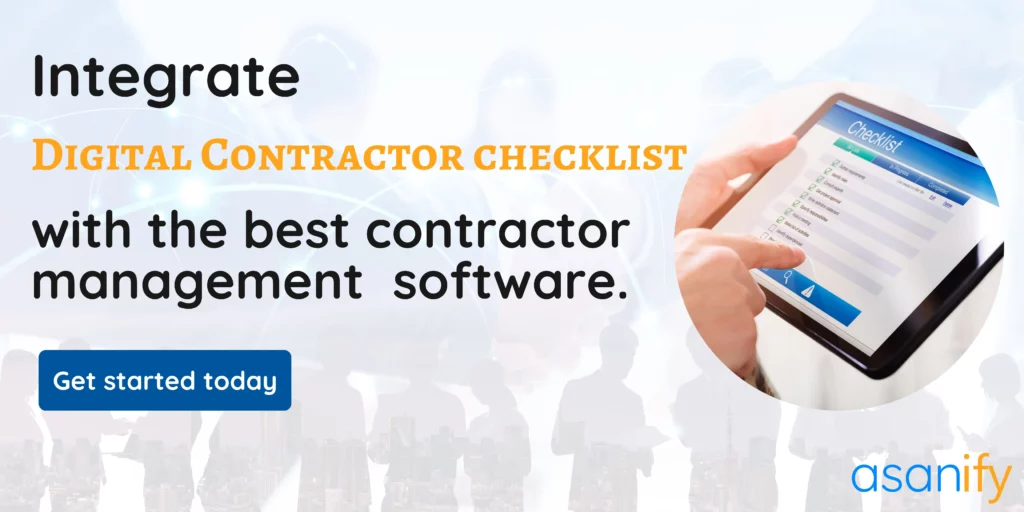Struggling with the constant hassle of managing your third-party workforce or independent contractors? Well, worry not! Because, we have got you covered. In this blog, you will get to know how important a contractor management checklist is in staying compliant and safeguarding your business from misclassification risks and penalties. So, let’s get going!
It is no longer a secret that, when you engage contractors in your business, you get to enjoy a myriad of benefits. Apart from getting access to the top-notch skillset of freelancers located globally, you get to save hefty overhead charges that otherwise accompany you while embarking on the process of hiring full-time employees. The fact can, in no way, be denied that contractors form a core part of your business as they engage in disseminating several functions critical to your business.
Being a business owner, you can’t ignore ticking off essential items from a contractor management checklist. To stay compliant, mitigate risks and enhance safety procedures, having an exhaustive contractor management checklist is crucial. Needless to say, crossing off items from an accurately prepared contractor management checklist forms an important component of the entire contractor management process. Using a contractor management software in conjunction with a checklist template will ensure a couple of vital things:
- That you have followed a steady set of steps in acknowledging the identity of a specific worker as a contractor and not an employee, thereby preventing misclassification risks
- That all the mandatory actions ranging from site inductions, onboarding to checking safety procedures has been duly completed before kick-starting work
Now that we have grabbed a basic idea of what a contractor management plan checklist is, let’s delve deep into its core details!
Table of Contents
- Download Contractor Management Checklist PDF for Free
- What is a Contractor Management Checklist?
- Why is a Contractor Management Checklist Important?
- What to Include in the Contractor Management Checklist?
- Example of a Contractor Management Checklist
- 7 Most Common Items to Include in a Contractor Management Checklist
- Top 11 Questions to Include in a Contractor Management Checklist to Avoid Employee Misclassification
- Industry-specific Considerations for Contractor Management
- How to Use a Contractor Management Checklist as a Part of the Contractor Management Process?
- How to Manage Contractor Management Checklist Digitally?
- Frequently Asked Questions- Contractor Management Checklist
Download Contractor Management Checklist PDF For Free
What is a Contractor Management Checklist?
A contractor management checklist is a tool used by organizations to ensure that proper procedures are followed when engaging and managing contractors for various projects or services. It typically includes a list of items that need to be addressed or verified throughout the contractor engagement process to ensure compliance with legal requirements, safety standards, and organizational policies.
To stay assured that the work outsourced to the cohort of third-party workers or contractors is carried out in accordance with the contract terms, workplace standards, and health and safety measures, using a contractor checklist becomes unavoidable. Irrespective of the nature and size of your business, having in place a contractor or subcontractor management checklist is essential. This is because the first step of an efficient contractor management process starts with verifying items from the contractor checklist.
The checklist will pose a series of conditions that need to be satisfied for an independent contractor to complete the work for which you have hired them. For instance, you might have to check if proper insurance or health and safety certificates are present before the contractor starts working. For on-site work, especially, ensuring the safety of contractors becomes critical. If any contractor gets hurt while working on-site for your business, it will become a huge liability for your company.
Often, at the time of internal and external audits, you might have to show apt documents to testify to the fact that every worker in your company is qualified to take up that task. Using a contractor checklist ensures that you have transitioned to a smooth and seamless contractor management process, having adhered to regulations and removing risk factors.
Why is a Contractor Management Checklist Important?
The better the contractor management process, the higher are the chances of the project getting completed successfully. And, as we reiterated before, a contractor checklist forms a core aspect of the entire contractor management process. Having a digital contractor checklist will give you great peace of mind. After all, things will be on track and you won’t miss out any important items. To achieve the set goals as defined in the contract and ensure that the safety regulations are being adhered to, using a contractor checklist emerges to be of supreme importance:
1. Ensuring Compliance
A contractor checklist helps ensure that your company adheres to legal and regulatory requirements when engaging contractors. By systematically checking off compliance-related items on the checklist, you succeed in reducing the risk of fines, penalties, and legal issues.
2. Risk Mitigation
Following a digital contract checklist aids you in identifying, assessing, and mitigating risks associated with contractor activities. The safety protocols mentioned in the checklist go above and beyond the basic regulations. In that way, you can be stay assured of the fact that both contractor and company safety is safeguarded from facing charges of law violations.
3. Maintains Accurate Documentation
When you use a contractor checklist embedded in a contractor management software, you get access to a comprehensive record of contractor management activities, including agreements, approvals, and performance evaluations at one place. As a result, tracking work progress of contractors becomes a breeze. Further, resolving disputes and demonstrating compliance during audits or legal proceedings becomes a cakewalk.
4. Ensures Accountability
Using a contractor checklist entails establishing accountability for your organization, as well as, the contractors. When you will use the checklist tool along with a contractor management software, establishing clarity on project expectations, milestones, and deliverables will be super simple. This will also ensure that the contractors understand their roles and responsibilities pretty well, reducing the likelihood of misunderstandings or disputes.
5. Fosters Continuous Improvement
Regular review and refinement of the checklist leaves you with the scope to identify opportunities for process optimization and enhancement. You can continuously enhance contractor management practices by incorporating feedback and lessons learned. This will further aid in adapting to changing needs and circumstances when needed.
What to Include in a Contractor Management Checklist?
Inclusions in a contractor checklist keep varying organization-wise, depending upon the unique goals and requirements of that organization. As a standard, you can include the following elements in the contractor checklist:
1. Pre-qualification Process
Before you hire a contractor, make sure to assess their qualifications, previous work experience while also reviewing the documents that they bring to the fore. As a part of the reviewing process, make sure to check the validity of contractors’ licenses and other certifications that they might possess. In that way, you will gain certainty about the fact that the contractors possess the necessary skillset needed to complete that particular work efficiently.
2. Safety Protocols
It is very important to follow safety measures and check if your contractors are working in perfect alignment with the established protocols. Ensuring that they are operating securely under absolutely safe conditions without undergoing any risks or meting out injuries is essential. After all, the idea is to carry out business functions while strictly following all the safety regulations because the workplace environment needs to be insulated from any kind of risks.
3. Contractual Terms & Conditions
Make sure to specify the scope of work and project expectations in the contract with clarity. This will help prevent any sort of misunderstandings or disputes between you and the contractor engaged in your business, going forward. The independent contractor agreement needs to be devised in a way that it protects the interests of both the parties while projecting the rights pertaining to your company and the contractor.
4. Contractor Insurance & Liability
Be clear in your stand while mandating contractors to carry proper insurance coverage. This is important to manage financial mishaps if contractors face any accidents. Make sure to include terms related to liability protections in the contract itself. In that way, there will be enough clarity established on responsibility allocation. Further, safeguarding against possible legal problems will also be possible.
Example of a Contractor Management Checklist
The items in an ideal contractor checklist template ought to be such that these reflect the fact that a chosen contractor is eligible and competent to complete the work, having satisfied all the necessary requirements. If you are not sure what exact items you need to include in the checklist, following this example will aid you in framing things. Let’s have a look at the common topics that you can include in a general contract or subcontractor management checklist:
- Contractor induction/onboarding and training
- Contractor management practices followed by the company
- Assessment of contractors’ skills and verification of relevant documents
- Risk mitigation
- Safety measures
- Monitoring or supervising the work that contractors are doing
- Things needed to be done upon the completion of the project
To make things further organized easy to comprehend, you may choose to divide the entire contractor checklist into certain sections such as:
- Contract execution
- Ongoing contract management process
- Contract renewal or extension terms
- Termination of the contract
Standard Questions to Include in a Contractor Checklist Template [Examples]
It is important to note that no contract is identical to another. This is because, the terms agreed to by both the parties keep varying. However, keeping in mind a standard format, you can include the following questions as a part of the contractor checklist template:
- Has the contractor induction and onboarding process been completed?
- Is the contractor in possession of valid insurance documents?
- How does the contractor demonstrate their capability?
- Are the certificates submitted by contractors valid?
- Is the contractor competent to exhibit Risk Assessments and Method Statements (RAMS) related to the work to be completed?
- Does the contractor possess any enforcement notice possibly issued to them by any competent authority?
- Did the contractor submit any document related to their health and safety policy?
- Is the independent contract agreement valid?
- Is there any condition stating that the contractor payment is intertwined with satisfactory performance?
- How is the health and safety history of the contractor?
- Are the work permits duly completed?
- Is there a prompt action be taken in case the contractor delivered sub-par or unsatisfactory work performance?
- Did the contractor meet all the obligations as mentioned in the independent contractor agreement?
If the answer to any question is a “No,” proper investigation needs to be done to assess the risk involved and thereby take suitable action to control it. To ensure that things get done smoothly, resorting to a contractor management software is much-needed. It will help you in managing contractors, keeping a tab on their work progress, overseeing their work hours, automating contractor payroll, and so on. Devising a contractor checklist will ensure that you have onboarded the right worker who will aid you in reaching your business goals efficiently.
7 Most Common Items to Include in a Contractor Onboarding Checklist
You may choose to include the following items in a contractor or subcontractor onboarding checklist:
- Confirmation of contractor induction or onboarding completion
- Safety measures
- Emergency procedures and overview of evacuation points (applicable for on-site tasks)
- Site visit completion confirmation
- Offering insurances
- Validation of safe workplace environment
- Acknowledgement of full comprehension of site policies
Top 11 Questions to Include in a Contractor Management Checklist to Avoid Employee Misclassification
Before any global contractor starts working for your company, it is important to check if they are compliant with the prevailing local labor laws. The question is how can you guarantee that independent contractors working for you organization are functioning compliantly. In such a case, including the following the questions in the contractor management checklist will assist you in figuring out if they are compliant with the law of the land:
- Does the independent contractor have completely liberty over the way they complete the task?
- Has the chosen contractor worked on more than one contract lasting for a definite term in the past?
- Does the contractor possess the autonomy to fix their own work schedule, that is, the way they are going to complete the project?
- Is it guaranteed that the independent contractor is not monitoring other employees or contractors?
- Does the contractor publicly admit their identity as self-employed rather than claiming to be an employee of your company?
- Is the contractor free to take up projects for other clients not related to your business?
- Does the contractor send you an invoice for payments or use an expense report?
- Is the contractor receiving payments as per the payment disbursal frequency mentioned in the agreement or getting it monthly as regular salary?
- Does the contractor adhere to the tax deadline and make payments on time?
- Is the contractor going to receive any training from the company prior to start working?
- Does the contractor carry proper insurance-related documents (health, property & liability)?
If the answer to any of the above question is a “no,” do know that your chosen contractor is not compliant with the local laws and regulations. As a result, there are greater risks of getting enmeshed in the trouble of worker misclassification charges.
Industry-specific Considerations for Contractor Management
Industry-specific considerations for contractor management vary owing to dynamic regulations, risks, and project requirements across different sectors. For instance, the work protocols differ from one another in the following industries:
Construction Industry
In construction, contractor management may involve compliance with specific safety standards, such as OSHA regulations. Further, it also involves ensuring that contractors possess proper licensing, insurance, and certifications for specialized tasks like electrical work or heavy machinery operation.
Healthcare Industry
Healthcare facilities must manage contractors who work in sensitive environments and adhere to strict patient privacy regulations (e.g., HIPAA). Contractor management tasks may involve additional background checks, training on patient confidentiality, and infection control measures.
Oil and Gas Industry
Contractor management in oil and gas involves stringent safety protocols due to the high-risk nature of operations. Contractors need to undergo specialized safety training, adhere to industry-specific regulations (e.g., API standards), and comply with environmental regulations.
Information Technology (IT) Industry
IT contractor management may focus on cybersecurity measures to protect sensitive data and systems. Security clearance checks, following strict access control procedures, and complying with data protection laws (e.g., GDPR, CCPA) are certain norms that a contractor needs to adhere to.
Manufacturing Industry
In manufacturing, contractor management may involve ensuring contractors follow specific quality control processes, adhere to production schedules, and comply with industry standards (e.g., ISO certifications). Safety training is also essential due to potential hazards in the workplace.
Retail Industry
Retailers may engage contractors for tasks like store renovations, security services, or IT support. Contractor management in retail may involve managing access to customer data, ensuring compliance with retail industry regulations, and maintaining a positive brand image. 
How to Use a Contractor Management Checklist as a Part of the Contractor Management Process?
Crafting a contractor management checklist and crossing things off are crucial. But, how do you ensure that you are using this checklist efficiently? That is, in a way to ensure that your entire process of managing independent contractors is going to be streamlined for real. Well, that is the reason, it is important to learn how you can integrate a contract monitoring checklist into the auditing process:
1. Start With Noting Down Basic Information
Start the process by adding basic details such as the name of your company, workers involved, relevant documents while elucidating on the objective of the Standard Operating Procedures (SOPs) that contractors need to abide by.
2. Undertake an Assessment Round of the Contractors
Assess the contractor profile and ascertain which specific operating procedures are a must to ensure success in the entire contractor management process.
3. Training and Familiarization
Provide training and guidance to personnel responsible for using the checklist. Ensure they understand how to effectively complete and interpret checklist items, as well as, how to address any issues or discrepancies that may arise.
4. Check Crucial Contractor Processes
Make sure to go into the depth of the mandatory contractor processes while assessing the checklist. Important areas that need close scrutiny are risk controls, safety measures, work permits, certifications and insurance-related documents of contractors. Point out any significant concerns at the time of evaluation and work towards prompt resolution of the problem.
5. Note Down Your Observations
Document the completion of checklist items at each stage of the contractor management process. Maintain accurate records of checklist submissions, approvals, and any corrective actions taken. Further, while evaluating the contractor checklist, note down any important findings that you come across. In that way, you will stay mindful of potential issues that need to addressed before the contract is executed. In short, summarizing your findings will help you in picking up minute details that would have otherwise got missed in the process of mere checklist reviewing.
6. Work Towards Quick Resolution of Issues
Consider it as your top priority to resolve the issues that you stumbled upon while reviewing the contractor management checklist. You may choose to assign the issue resolution tasks to your team members so that any kind of errors or discrepancies get sorted out quickly. This will, in turn, expedite the contractor onboarding process and project delivery will happen at your anticipated time. Steering clear of problems is essential before you start working with any contractor.
7. Conclude the Checklist Auditing Process With Signature
It is a good idea to conclude the checklist auditing process by sealing it with signatures of the auditor and other professionals who were a part of this task. Doing so will enable you to go back to the concerned persons involved in the checklist review process, in case any need arises.
How to Manage Contractor Management Checklist Digitally?
Preparing contractor checklists manually, making edits multiple times, correcting errors- are something that you definitely won’t want to come across. On top of that, the lingering stress of managing contractors won’t let you work in peace. You will probably have lots of other things to look after. And, who will ever want to compromise on the core business strategizing operations to make contractor checklists traditionally? It is important to go digital and embrace a smart contract management software to streamline the entire work methodology. You can easily integrate the contractor management plan checklist into the software platform you are using. The result? You will experience how enhanced the entire contractor management process has become! Let’s see how you can use a contractor checklist digitally with the aid of a flexible contract management software:
1. Select a Suitable Contractor Management Software
Choose a contractor management software that offers customizable features and supports the integration of digital checklists. Look for platforms that align with your organization’s needs, scalability, and budget.
2. Customize the Contractor Management Plan Checklist Template
Design a digital checklist template within the software platform that encompasses all necessary tasks, requirements, and criteria for contractor management. Customize the checklist fields, categories, and instructions to align with your organization’s processes.
3. Integrate the Checklist into the Software
Integrate the digital checklist seamlessly into the contractor management software interface. Ensure that users can access the checklist directly from the software platform and that it is synchronized with other relevant modules, such as contractor profiles and project management tools.
4. Automate Contractor Checklist Assignments
Utilize automation features within the software to assign checklist tasks to relevant stakeholders automatically. Set up notifications and reminders to alert users about upcoming deadlines, pending tasks, or required actions related to the checklist.
5. Facilitate Real-Time Updates and Collaboration
Enable real-time updates and collaboration features within the software to allow multiple users to access and modify the checklist simultaneously. Incorporate commenting, messaging, and file-sharing functionalities to facilitate communication and collaboration among stakeholders.
6. Implement Electronic Signatures and Approvals
Integrate electronic signature and approval capabilities into the contractor management checklist workflow to streamline the validation process. Enable users to electronically sign off on completed checklist items, indicating acknowledgment and compliance.
7. Track and Monitor Checklist Progress
Utilize tracking and monitoring tools within the contractor management software to monitor checklist progress and completion status in real-time. Generate reports and dashboards to visualize performance metrics, identify bottlenecks, and track compliance with checklist requirements.
Frequently Asked Questions- Contractor Management Checklist
1. What is a contractor management checklist, and why is it important?
A contractor management checklist is a tool used by organizations to ensure that proper procedures are followed when engaging and managing contractors for various projects or services. It’s important because it helps ensure compliance with legal requirements, safety standards, and organizational policies, while also reducing risks and improving efficiency.
2. What should be included in a contractor management checklist?
A contractor management checklist should include items such as verifying contractor qualifications, ensuring compliance with regulations, defining scope of work, establishing contract terms, providing necessary training, monitoring performance, and maintaining documentation.
3. How can a contractor management checklist improve compliance?
By outlining specific requirements and procedures, a contractor management checklist helps ensure that all necessary steps are taken to comply with legal and regulatory obligations. It serves as a guide for both contractors and organizations to follow, reducing the risk of non-compliance and associated penalties.
4. What are the benefits of using a digital contractor management checklist?
Using a digital contractor management checklist offers benefits such as easier accessibility, real-time updates, automated notifications, improved collaboration, enhanced security, and better data management compared to traditional paper-based checklists.
5. How often should a contractor management checklist be reviewed and updated?
A contractor management checklist should be reviewed and updated regularly to reflect changes in regulations, policies, project requirements, and lessons learned from previous contractor engagements. It’s recommended to conduct reviews at least annually or as needed based on organizational changes.
6. Can a contractor management checklist be customized for different projects or industries?
Yes, a contractor management checklist can and should be customized to meet the specific needs and requirements of different projects, industries, and organizations. This ensures that the checklist remains relevant and effective in addressing unique challenges and considerations.
7. What is a Contractor Safety Management?
Contractor safety management involves implementing processes and procedures to ensure the safety of contractors who work on behalf of an organization. This includes assessing and mitigating risks associated with contractor activities, providing necessary safety training and resources, and monitoring compliance with safety regulations. Effective contractor safety management aims to prevent accidents, injuries, and hazards in the workplace while promoting a safe working environment for everyone involved.
8. What role does a contractor management checklist play in risk management?
A contractor management checklist helps identify, assess, and mitigate risks associated with contractor activities, such as safety hazards, compliance issues, and project delays. By addressing potential risks upfront and implementing appropriate measures, organizations can minimize disruptions and liabilities.
9. How does a contractor management checklist contribute to organizational efficiency?
A contractor management checklist streamlines processes, improves communication, and ensures consistency in contractor management practices. By providing a structured framework and guidelines to follow, it helps save time, reduce errors, and optimize resource allocation, leading to increased efficiency and productivity.
10. What should organizations consider when selecting a contractor management software to complement their checklist?
When selecting a contractor management software, organizations should consider factors such as customization options, integration capabilities, user-friendliness, scalability, security features, customer support, and cost-effectiveness to ensure it aligns with their specific needs and requirements.
11. How can organizations ensure effective implementation and adoption of a contractor management checklist?
Effective implementation and adoption of a contractor management checklist require clear communication, training, stakeholder engagement, and continuous improvement efforts. Organizations should ensure buy-in from all relevant parties, provide adequate support and resources, and regularly evaluate and adjust their processes based on feedback and outcomes.
12. How often should a contractor management checklist be updated?
Not to be considered as tax, legal, financial or HR advice. Regulations change over time so please consult a lawyer, accountant or Labour Law expert for specific guidance.








